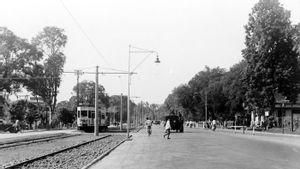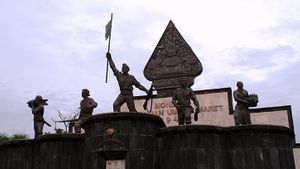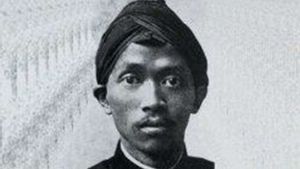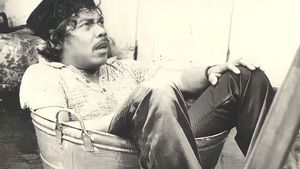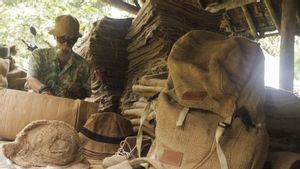JAKARTA - Today 95 years ago, March 16, 1927, was a big day in the life rite of the writer Ramadhan Karta Hadimadja (Ramadhan K.H). He was born and died on that date. During his lifetime, he transformed into a great writer. Also a great biographer. A number of big figures have used his services. From Bung Karno's second wife, Inggit Garnasih to Suharto. Therefore, he became an important figure in the development of Indonesian literature.
Perhaps one word is not enough when describing the figure of Ramadhan KH who was born on March 16, 1927, in Bandung. It can cover everything. He can play a role as a poet, novelist, historian, to humanist. All of the roles were performed equally well. On the one hand, he can narrate history well. On the other hand, he is able to give life to fiction writing.
He got the skill because Ramadan was thirsty for knowledge. He never squandered every opportunity to learn. Wherever it is and it doesn't matter who it is with. Ramadan is never absent. For example, he went to the Netherlands to study local culture in 1951.

He joined a group of famous Indonesian poets, writers, and painters. Among others, Asrul Sani, Sitor Situmorang, Pramoedya Ananta Toer, to Mochtar Apin. His involvement among the big figures made Ramadhan learn many things.
“In 1951, with the help of Sticusa, the foundation for Dutch-Indonesian cultural cooperation, a number of poets, authors, and painters were given the opportunity to visit the Netherlands. They were Asrul Sani and his wife Nuraini, Pramoedya and his first wife, Sitor Situmorang, Gayus Siagian, Ach Kartahadimadja, M. Balfas, Barus Siregar, Mochtar Apin, Roesli, and Ramadhan KH Atun (his nickname) returned to Indonesia in 1955. He became the editor of Kisah Magazine, moved to Siasat Magazine. In Siasat he takes care of the cultural rubric: Gelanggang (Arena).”
“Atun together with Ajib Rosidi were among the people who convinced DKI Jaya Governor Ali Sadikin to form the Taman Ismail Marzuki Arts Center (TIM). In TIM Atun manages the Jakarta Arts Council (DKJ) behind Asrul Sani, Ajib Rosidi, and Iravati Sudiarso. His character as the gentle lieutenant is obvious. He is the gentle companion of his two diplomat wives, namely Pruistin or Tines and Salfrida Nasution or Ida," said Rosihan Anwar in the book Sejarah Kecil “Petite Histoire” Indonesia Jilid 3 (2009).
After that, his work is abundant. There is more than one work in the form of a novel. Some of them were Royan Revolusi (1968), Kemelut Hidup (1977), Keluarga Permana (1978), dan Ladang Perminus (1987). Not infrequently his work is also made into a film. Kemelut Cinta, for example.
His odyssey in his work did not end. He always tries new things. As a result, his name has returned to fame as a reliable biographer. Many are waiting for his services to write a biography. Because the reader seems to have an emotional connection with the characters he tells.

In other words, the writing is so alive. After all, not infrequently the label "bestseller" is often imprinted with his biographies. Includes a biography of Inggrit Garnasih. Inggit's struggle to accompany Bung Karno is well described. He was also faithful to write until death picked him up the same as the date of his birth: March 16, 2006, in Cape Town, South Africa.
“Outside of fiction, his name is also remembered as the author of special biographical 'orders'. A biography of Bung Karno's wife when he was a student in Bandung: Technische Hoogeschool (now: ITB), presented in Kuantar ke Gerbang: Kisah Cinta lbu Inggit dengan Bung Karno (1981). About the second most durable Indonesian President in power, he wrote Soeharto: Pikiran, Ucapan, dan Tindakan Saya (1991).”
“Then, about the prima donna of opera aristocrats who are models of old Indonesian integrated theater, he wrote Gelombang Hidupku: Dewi Dja dari Dardanella (1982). About the founder of the red beret corps, he wrote A.E. Kawilarang: Untuk Sang Merah-Putih (1988),” concluded Remy Sylado in his article in Tempo Magazine entitled Ramadhan, Kembali Ke Pangkuan Asal (2006).
*Read other information about TODAY'S HISTORY or read other interesting articles from Detha Arya Tifada.
VOIR éGALEMENT:
The English, Chinese, Japanese, Arabic, and French versions are automatically generated by the AI. So there may still be inaccuracies in translating, please always see Indonesian as our main language. (system supported by DigitalSiber.id)



